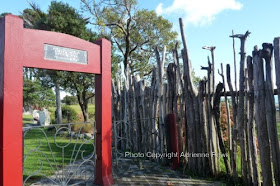

I took these two photographs in
Auckland Museum last year. I was taken not only with the beauty of the carving but also the story behind how they came to be there. The boards were created in the late 18th century by the
Te Whanau-a-Apanui people of the eastern Bay of Plenty (East Cape) at
Maraenui, near Te Kaha. The museum exhibit shows the central barge boards (
maihi) and doorway (
kuwaha) of a
pataka (storehouse), which was dismantled in the early 1820s and moved to
Raukokere, where new carvings were begun. Before they were completed they were hidden in a cave at Te Kaha to protect them from the 1823 raids by the Northland Ngapuhi tribe. They were recovered from the cave in the 1890s and bought by the Auckland Museum in 1912. I have featured the
Maraenui Marae, Te Kaha and Raukokere on this blog previously. Just click on any of the names in the label line below this post to take you to photographs of each of them.

 When I was in Dunedin last week and the rain fell, I retreated to Otago Museum to test my new camera in low light without flash. I have to say I was delighted with the results and what seemed like a gross over-indulgence when I bought it now seems like a very sound investment. And so to these stunning carvings...... They were made by Ngati Porou carvers near Napier in the late 1870s for the Hawke's Bay chief, Karaitiana Takamoana, who planned to erect a whare Runanga where they would feature. Unfortunately he died in 1979 and the incompleted carvings were abandoned. Dr T.M Hocken, who had heard of the carvings, secured their loan for the New Zealand Exhibition of 1889-90, where they were set up as a house. At the conclusion of the exhibition, Hocken purchased the carvings and gifted them to Otago Museum - which, I have to say, has a small but very beautiful collection of Maori artefacts. www.otagomuseum.govt.nz (These notes from the Otago Museum exhibition labels).
When I was in Dunedin last week and the rain fell, I retreated to Otago Museum to test my new camera in low light without flash. I have to say I was delighted with the results and what seemed like a gross over-indulgence when I bought it now seems like a very sound investment. And so to these stunning carvings...... They were made by Ngati Porou carvers near Napier in the late 1870s for the Hawke's Bay chief, Karaitiana Takamoana, who planned to erect a whare Runanga where they would feature. Unfortunately he died in 1979 and the incompleted carvings were abandoned. Dr T.M Hocken, who had heard of the carvings, secured their loan for the New Zealand Exhibition of 1889-90, where they were set up as a house. At the conclusion of the exhibition, Hocken purchased the carvings and gifted them to Otago Museum - which, I have to say, has a small but very beautiful collection of Maori artefacts. www.otagomuseum.govt.nz (These notes from the Otago Museum exhibition labels).

















































